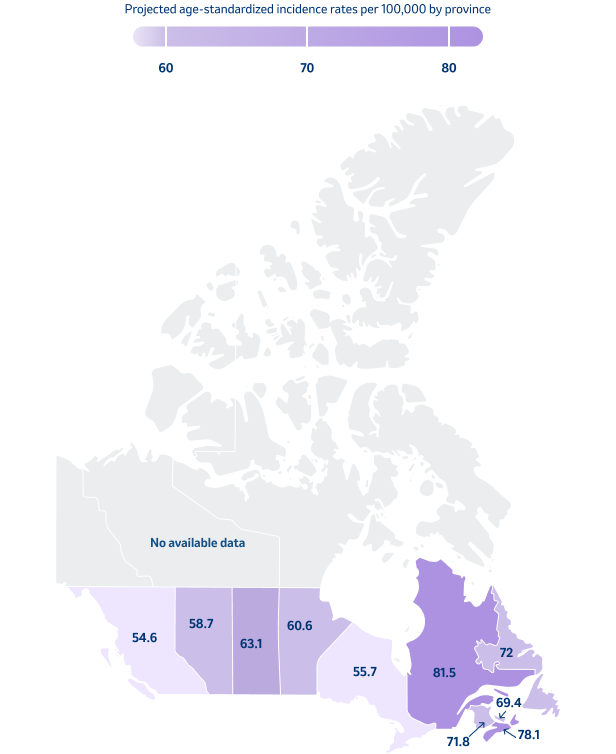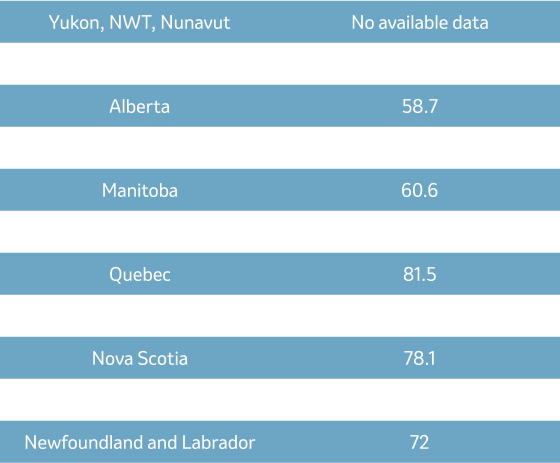A DEEP BREATH CAN
HELP YOU SEE THINGS
MORE CLEARLY.
Learn more about lung cancer, and talk to your healthcare professional.

LUNG CANCER IS THE MOST COMMONLY DIAGNOSED CANCER IN CANADA.
LUNG CANCER IN NUMBERS:
~1 in 14
Canadians will develop lung and bronchus cancer in their lifetime, according to estimates.


98%
of cases occur in adults 50+ years of age.

50%
of all lung cancer cases are diagnosed late at Stage 4.
CANADIAN LUNG CANCER PROJECTIONS FOR 2024:

Lung cancer will be the leading cause of cancer death, making up approximately 23% of all cancer-related deaths.

32,100 Canadians will be diagnosed with lung cancer in 2024. This accounts for 13% of all new cancer cases.

The number of new lung cancer cases are expected to be higher in females than males, with female cases expected to be 17,300 and males to be 14,800.

PROJECTED LUNG CANCER CASES IN CANADA IN 2024

Adapted from Brenner et al.
In 2024, lung cancer rates and deaths are estimated to be highest in the Eastern and Atlantic provinces.
THE SIGNS AND SYMPTOMS OF LUNG CANCER CAN BE SUBTLE.
In its early stages, lung cancer may not show any symptoms. However, your body may still send subtle signals that something isn’t quite right. Paying attention to these signs could be the key to early detection and better outcomes.
If someone you love is experiencing any of the following symptoms, encourage them to see their healthcare professional right away:
Cough
- A cough that has lasted for more than 3 weeks
- A cough that doesn’t go away or gets worse
- Coughing up blood
Pain
- Constant chest pain that gets worse when breathing deeply
- Persistent chest or shoulder pain
- Pain when swallowing
Fatigue
- Exhaustion after small amounts of physical activity
- Tiredness that does not go away after sleeping or resting
Unintentional weight loss
- Weight loss without changes to your diet OR activity level
Wheezing/Feeling Breathless/Hoarseness
- A whistling sound in your chest when breathing
- Feeling like you cannot get enough air
- Feeling like you cannot catch your breath
- Your voice is strained or lower pitch for more than 3 weeks
Infections
- Chest infections that keep coming back
- Chest infections that don’t get better
Some people can go misdiagnosed for a long time, because lung cancer symptoms are similar to other conditions, like pneumonia, allergies or a cold.
If you feel that something is wrong with you or a loved one, consult a healthcare professional.
YOUR LUNGS TELL A STORY.
LISTEN CLOSE.
THEY MAY HAVE SOMETHING IMPORTANT TO TELL YOU.


Take our assessment to help you to identify some common signs of lung cancer and its risk factors.
ANYONE CAN GET LUNG CANCER, BUT SOME PEOPLE ARE MORE AT RISK.†
A risk factor is something that increases your chances of developing cancer. Most cancers are caused by a combination of risk factors.
Some of these risks, like smoking, are within your control, while others, like family history, are not. By understanding and managing these risks, you can help reduce your chance of developing lung cancer.
From 2020 to 2045, it is estimated that there will be 623,500 potentially preventable cases of lung cancer†
Modifiable risk factors:

Smoking
- Smoking tobacco is the leading cause of lung cancer.
- People who smoke are about 20 times more likely to develop lung cancer than non-smoking people.
- The longer and more a person smokes, the higher their risk.
- While tobacco smoking has decreased dramatically over the last 50 years, tobacco still accounts for about 72% of all lung cancer cases.
It’s never too late to quit
Quitting smoking at any age can help reduce the risk of developing lung cancer.

Second-hand smoke
Second-hand smoke is a main risk factor for lung cancer among non-smoking people
Exposure to second-hand smoke in the home can increase risk of cancer by 20-30% in people who have never smoked.

Chemicals
Radon exposure:
Is a colourless, odourless gas from the natural breakdown of uranium in rock and soil. It can become hazardous when trapped indoors and the risk of lung cancer depends on radon exposure levels.
Air pollution:
Consists of harmful chemicals or particles in the air. High pollution areas, like large cities, have been linked to an increased risk of lung cancer. The more a person is in air pollution, the higher their risk.
Work-related chemicals:
Certain industries may expose workers to cancer-causing chemicals like asbestos, diesel exhaust, and more. High-risk industries include construction, transportation, mining, and certain manufacturing sectors.
Lung cancer is one of the most preventable cancers in Canada.
In 2020, more than 80% of lung cancer cases were caused by risk factors that we can change.
Non-modifiable risk factors†
Some risk factors can’t be controlled.

Age
- Your risk of developing lung cancer increases with age.
- 98% of lung cancer diagnoses are expected to occur in people 50 years of age or older.

Family history
If you have a first-degree relative (a brother, sister, child, or parent) who has had lung cancer, especially if they were diagnosed at a younger age, you may be at a higher risk of developing lung cancer.

Personal history of lung cancer and lung disease
Certain lung diseases or conditions can cause scarring in the lungs. If you previously had lung cancer, your risk of developing another lung cancer may be higher.

Weakened immune system
Certain conditions, such as HIV infection and AIDS, may weaken the immune system. Individuals with weakened immune systems may be at higher risk of developing many types of cancer, including lung cancer.
Talk to a healthcare professional to learn about changes you can make to reduce your risk of lung cancer.
Encourage your loved ones to have these important conversations with their healthcare professional.
WHAT IS LUNG CANCER?
Types of lung cancer
Primary lung cancer starts in the lung cells. Lung cancers are usually divided into two types:
- Small cell lung cancer – Usually starts in the cells that line the bronchi (large airways) in the centre of the lungs.
- Non-small cell lung cancer – More common than small cell lung cancer. It usually starts in glandular cells on the outer part of the lung. It may also begin in the cells that line the bronchi (large airways).
When other types of cancer spread to the lungs from other parts of the body, it’s called lung metastasis.
When lung cancer spreads
Lung cancer begins in the lungs and can spread to other parts of the body. Not all lung cancers will spread. But if the cancer does spread there are certain parts of the body that it is more likely to go to.
Lung cancers are most likely to spread to your:
- Other lung
- Adrenal gland
- Bones
- Brain
- Liver
YOUR LUNGS TELL A STORY. LISTEN CLOSE.
While the possibility of a cancer diagnosis can be frightening, early detection of lung cancer is essential.
Lung cancers are often found late. Be sure and talk to your healthcare professional now if you have any concerns.
† Please note that this list is not exhaustive and there are other risk factors for, and symptoms of, lung cancer. If you have any questions about lung cancer risk factors or symptoms, be sure to ask a healthcare professional.
‡ When considering the following known and possible modifiable risk factors: tobacco, physical inactivity, residential radon, air pollution, second-hand smoke, low fruit consumption and low vegetable consumption.

